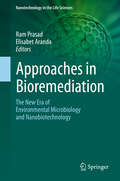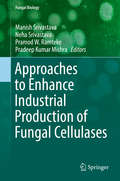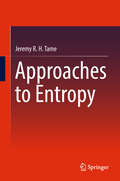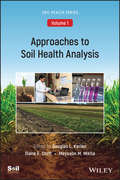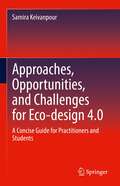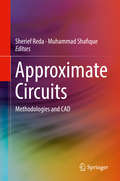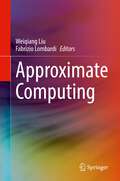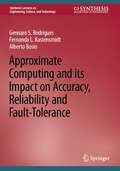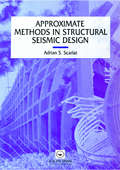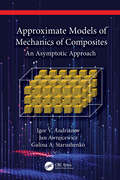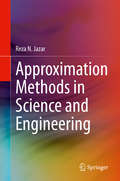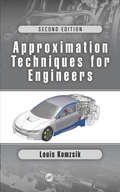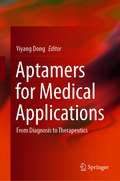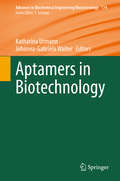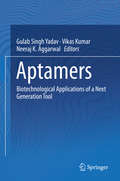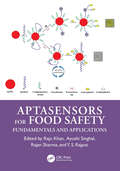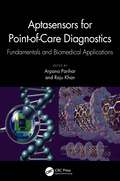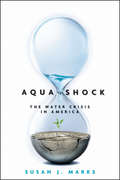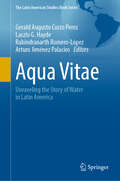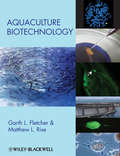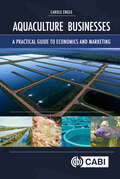- Table View
- List View
Approaches in Bioremediation: The New Era of Environmental Microbiology and Nanobiotechnology (Nanotechnology in the Life Sciences)
by Ram Prasad Elisabet ArandaBioremediation refers to the clean‐up of pollution in soil, groundwater, surface water, and air using typically microbiological processes. It uses naturally occurring bacteria and fungi or plants to degrade, transform or detoxify hazardous substances to human health or the environment.For bioremediation to be effective, microorganisms must enzymatically attack the pollutants and convert them to harmless products. As bioremediation can be effective only where environmental conditions permit microbial growth and action, its application often involves the management of ecological factors to allow microbial growth and degradation to continue at a faster rate. Like other technologies, bioremediation has its limitations. Some contaminants, such as chlorinated organic or high aromatic hydrocarbons, are resistant to microbial attack. They are degraded either gradually or not at all, hence, it is not easy to envisage the rates of clean-up for bioremediation implementation.Bioremediation represents a field of great expansion due to the important development of new technologies. Among them, several decades on metagenomics expansion has led to the detection of autochthonous microbiota that plays a key role during transformation. Transcriptomic guides us to know the expression of key genes and proteomics allow the characterization of proteins that conduct specific reactions. In this book we show specific technologies applied in bioremediation of main interest for research in the field, with special attention on fungi, which have been poorly studied microorganisms. Finally, new approaches in the field, such as CRISPR-CAS9, are also discussed. Lastly, it introduces management strategies, such as bioremediation application for managing affected environment and bioremediation approaches. Examples of successful bioremediation applications are illustrated in radionuclide entrapment and retardation, soil stabilization and remediation of polycyclic aromatic hydrocarbons, phenols, plastics or fluorinated compounds. Other emerging bioremediation methods include electro bioremediation, microbe-availed phytoremediation, genetic recombinant technologies in enhancing plants in accumulation of inorganic metals, and metalloids as well as degradation of organic pollutants, protein-metabolic engineering to increase bioremediation efficiency, including nanotechnology applications are also discussed.
Approaches to Enhance Industrial Production of Fungal Cellulases (Fungal Biology)
by Neha Srivastava Manish Srivastava Pramod W. Ramteke Pradeep Kumar MishraCellulase is a key enzyme of industrial interest and plays a crucial role in the hydrolysis of cellulose, a prime component of plant cell walls. Cellulase covers a broad area in the global market of industrially important enzymes and it is considered as the third largest industrial enzyme globally. Additionally, cellulase contributes about 20% of the total enzyme market globally because of its massive demand in various industries such as in biofuel production, pulp, paper, textile, food, and beverages, as well as in detergent industries. Among these, the demand of cellulase may become frequently selected in the commercial production of biofuels in the future and thus will further increase demand of cellulase in the biofuel industry. Because biofuel production is still not realized in a cost-effective, practical implementation due to its high cost (the higher cost of biofuels is due to higher production costs of enzymes), there is a need to introduce these types of approaches, which will help to lower the cost of enzyme production for developing overall economic biofuel production.
Approaches to Entropy
by Jeremy R. TameThis is a book about thermodynamics, not history, but it adopts a semi-historical approach in order to highlight different approaches to entropy. The book does not follow a rigid temporal order of events, nor it is meant to be comprehensive. It includes solved examples for a solid understanding. The division into chapters under the names of key players in the development of the field is not intended to separate these individual contributions entirely, but to highlight their different approaches to entropy. This structure helps to provide a different view-point from other text-books on entropy.
Approaches to Road Safety: Evolution, Challenges, and Emerging Technologies
by Peter SweatmanRoad transport is on a constant course to maintain and improve driving safety in what is a complex process involving multiple forms of risk. It is time for embracing system technologies that give more meaning to the philosophical phrase "safe system" and Approaches to Road Safety: Evolution, Challenges, and Emerging Technologies makes the case for the adoption of safer systems in road transport industries through the embracing of technological paradigms, system attributes and more clearly articulated values. This book offers an account of the professional road safety enterprise in action in the United States, Australia and elsewhere, covering the contributions of Haddon in the 1960s, the creation of NHTSA, the development of the science of human factors, the enduring philosophy of countermeasures to motor vehicle crashes, motor vehicle safety regulations, occupant restraint and protection, collision avoidance, road and traffic design, driver assistance systems, pre-crash scenarios and vulnerable road users. It addresses the harm caused by roadway collisions, including the strategies of Vision Zero and the safe system. It places the enterprise of road safety within the greater system of road vehicle transportation. It also covers ethical preoccupations besides safety, including the rise of sustainability and its operational challenges, including uneven professionalism. Automation and the rise of driverless vehicles are discussed with these being described as a useful long-term change-agent in transportation systems. The important paradigm of connected vehicles and infrastructure is also described, along with the under-utilized science of human factors. The reader is exposed to a nuanced look at the world of road transport safety through its beginnings to the modern age of automation, allowing them to have a contextualized view of the subject area.Offering valuable insights, this book will appeal to professionals in the fields of safety, human factors, the automotive industry, traffic control, vehicle standards and regulations, transportation systems and road safety policy.
Approaches to Soil Health Analysis (ASA, CSSA, and SSSA Books #190)
by Douglas L. Karlen Diane E. Stott Maysoon M. MikhaApproaches to Soil Health Analysis A concise survey of soil health analysis and its various techniques and applications The maintenance of healthy soil resources provides the foundation for an array of global efforts and initiatives that affect humanity. Whether they are working to combat food shortages, conserve our ecosystems, or mitigate the impact of climate change, researchers and agriculturalists the world over must be able to correctly examine and understand the complex nature of this essential, fragile resource. These new volumes have been designed to meet this need, addressing the many dimensions of soil health analysis in chapters that are concise, accessible and applicable to the tasks at hand. Soil Health, Volume One: Approaches to Soil Health Analysis provides a well-rounded overview of the various methods and strategies available to analysists, and covers topics including: The history of soil health and its studyChallenges and opportunities facing analysistsMeta-data and its assessmentApplications to forestry and urban land reclamationFuture soil health monitoring and evaluation approaches Offering a far-reaching survey of this increasingly interdisciplinary field, this volume will be of great interest to all those working in agriculture, private sector businesses, non-governmental organizations (NGOs), academic-, state-, and federal-research projects, as well as state and federal soil conservation, water quality and other environmental programs.
Approaches, Opportunities, and Challenges for Eco-design 4.0: A Concise Guide for Practitioners and Students
by Samira KeivanpourThis book addresses the implications of the Industry 4.0 paradigm in design for the environment. We examine the opportunities for, and challenges of, the implications of cyber-physical systems, big data analytics, Internet of things, additive manufacturing, and simulation in a range of areas in an eco-design context. These include selecting low impact materials, choosing manufacturing processes with environmental considerations, end of life strategies, applying design approaches for disassembly, integrating economic and social components into environmental studies, and stakeholder’s involvement. This volume takes a step toward this journey to explore how the three pillars of technology, sustainability, and evolving consumers could shape the future of the product’s design.
Approximate Arithmetic Circuit Architectures for FPGA-based Systems
by Akash Kumar Salim UllahThis book presents various novel architectures for FPGA-optimized accurate and approximate operators, their detailed accuracy and performance analysis, various techniques to model the behavior of approximate operators, and thorough application-level analysis to evaluate the impact of approximations on the final output quality and performance metrics. As multiplication is one of the most commonly used and computationally expensive operations in various error-resilient applications such as digital signal and image processing and machine learning algorithms, this book particularly focuses on this operation. The book starts by elaborating on the various sources of error resilience and opportunities available for approximations on various layers of the computation stack. It then provides a detailed description of the state-of-the-art approximate computing-related works and highlights their limitations.
Approximate Circuits: Methodologies and CAD
by Muhammad Shafique Sherief RedaThis book provides readers with a comprehensive, state-of-the-art overview of approximate computing, enabling the design trade-off of accuracy for achieving better power/performance efficiencies, through the simplification of underlying computing resources. The authors describe in detail various efforts to generate approximate hardware systems, while still providing an overview of support techniques at other computing layers. The book is organized by techniques for various hardware components, from basic building blocks to general circuits and systems.
Approximate Computing
by Weiqiang Liu Fabrizio LombardiThis book explores the technological developments at various levels of abstraction, of the new paradigm of approximate computing. The authors describe in a single-source the state-of-the-art, covering the entire spectrum of research activities in approximate computing, bridging device, circuit, architecture, and system levels. Content includes tutorials, reviews and surveys of current theoretical/experimental results, design methodologies and applications developed in approximate computing for a wide scope of readership and specialists.Serves as a single-source reference to state-of-the-art of approximate computing;Covers broad range of topics, from circuits to applications;Includes contributions by leading researchers, from academia and industry.
Approximate Computing and its Impact on Accuracy, Reliability and Fault-Tolerance (Synthesis Lectures on Engineering, Science, and Technology)
by Alberto Bosio Gennaro S. Rodrigues Fernanda L. KastensmidtThis book introduces the concept of approximate computing for software and hardware designs and its impact on the reliability of embedded systems. It presents approximate computing methods and proposes approximate fault tolerance techniques applied to programmable hardware and embedded software to provide reliability at low computational costs. The book also presents fault tolerance techniques based on approximate computing, thus presenting how approximate computing can be applied to safety-critical systems.
Approximate Iterative Algorithms
by Anthony Louis AlmudevarIterative algorithms often rely on approximate evaluation techniques, which may include statistical estimation, computer simulation or functional approximation. This volume presents methods for the study of approximate iterative algorithms, providing tools for the derivation of error bounds and convergence rates, and for the optimal design of such
Approximate Methods in Structural Seismic Design
by A. ScarlatThis book examines the recent developments in computerized structural analysis and finite element analysis to re-appraise existing approximate techniques and to define their scope and limits more accurately. The book proposes new techniques and provides many numerical examples and comparisons with 'accurate' methods.
Approximate Models of Mechanics of Composites: An Asymptotic Approach
by Jan Awrejcewicz Igor V. Andrianov Galina A. StarushenkoApproximate Models of Mechanics of Composites: An Asymptotic Approach is an essential guide to constructing asymptotic models and mathematical methods to correctly identify the mechanical behavior of composites. It provides methodology for predicting and evaluating composite behavior in various structures, leading to accurate mathematical and physical assessments. The book estimates the error of approximations through comparing asymptotic solutions with the results of numerical and analytical solutions to gain a holistic view of the data. The authors have developed asymptotic models based on mathematical and physical rigorous approaches, which include three-phase models of fibrous composites, a modernized three-phase composite model with cylindrical inclusions, and models of two-dimensional composites of hexagonal structure. Also covered are two-phase models of composites related to the Maxwell formula and a percolation transition model for elastic problems based on the self-consistency method and Padé approximations. By obtaining analytical expressions to effectively characterize composite materials, their physical and geometric parameters can be accurately assessed. This book suits engineers and students working in material science, mechanical engineering, physics, and mathematics, as well as composite materials in industries such as construction, transport, aerospace, and chemical engineering.
Approximation Methods in Science and Engineering
by Reza N. JazarApproximation Methods in Engineering and Science covers fundamental and advanced topics in three areas: Dimensional Analysis, Continued Fractions, and Stability Analysis of the Mathieu Differential Equation. Throughout the book, a strong emphasis is given to concepts and methods used in everyday calculations. Dimensional analysis is a crucial need for every engineer and scientist to be able to do experiments on scaled models and use the results in real world applications. Knowing that most nonlinear equations have no analytic solution, the power series solution is assumed to be the first approach to derive an approximate solution. However, this book will show the advantages of continued fractions and provides a systematic method to develop better approximate solutions in continued fractions. It also shows the importance of determining stability chart of the Mathieu equation and reviews and compares several approximate methods for that. The book provides the energy-rate method to study the stability of parametric differential equations that generates much better approximate solutions.
Approximation Techniques for Engineers: Second Edition
by Louis KomzsikThis second edition includes eleven new sections based on the approximation of matrix functions, deflating the solution space and improving the accuracy of approximate solutions, iterative solution of initial value problems of systems of ordinary differential equations, and the method of trial functions for boundary value problems. The topics of th
Aptamers for Medical Applications: From Diagnosis to Therapeutics
by Yiyang DongThis book outlines comprehensively the main medical uses of aptamers, from diagnosis to therapeutics in fourteen chapters. Pioneering topics covered include aptamer pharmaceuticals, aptamers for malign tumors, aptamers for personalized therapeutics and aptamers for point-of-care testing. The book offers an essential guide for medical scientists interested in developing aptamer-based schemes for better theranostics. It is therefore of interest for not only academic researchers, but also practitioners and medical researchers in various fields of medical science, medical research and bio-analytical chemistry.
Aptamers in Biotechnology (Advances in Biochemical Engineering/Biotechnology #174)
by Johanna-Gabriela Walter Katharina UrmannThis book reviews the development, characterization and applications of aptamers in different areas of biotechnology ranging from therapeutics to diagnostics and protein purification. Hailed as chemical antibodies, these single-stranded nucleic acid receptors were predicted to supersede antibodies in traditional assays, such as ELISA, within a short time. While this has yet to happen, readers will find in this book a deep insight into the progress of aptamer technology and a critical discussion about the limitations that need to be overcome in order to find wider acceptance and use outside of the still relatively small aptamer-community. This book covers all aspects of aptamer generation and application for the aptamer-experienced reader and curious novice alike, with the addition of an industry perspective on the future of aptamer-use in biotechnology.
Aptamers: Biotechnological Applications of a Next Generation Tool
by Vikas Kumar Gulab Singh Yadav Neeraj K. AggarwalThe book discusses the basics of aptamers and the advent of aptamer-based technology in recent times. The book covers the diverse applications of aptamers, such as in detection of animal and plant pathogens, disease diagnosis and therapeutics, environmental contamination detection etc. Besides these applications, the book also describes the use of these synthetic or modified DNA, as drug delivery vehicles.The different chapters describe how the binding capacity and specificity of aptamers can be exploited in various ways. The book also discusses how these attributes of aptamers can outdo the antibody technology in biomedical and diagnostic solutions. This crisp and concise book gives the readers an insight into the most recent biotechnological applications of aptamers.
Aptasensors for Food Safety: Fundamentals and Applications
by Rajan Sharma Raju Khan Ayushi Singhal Y. S RajputThis reference book provides updated knowledge on fundamentals and applications of aptasensorsin food science. It discusses aptamer selection strategies including Systematic Evolution of Ligandsthrough EXponential enrichment (SELEX), Capture SELEX, Cell SELEX, and GO SELEX strategiesfor aptasensor design involving well-studied and newly emerged nanomaterials, food analysisfocusing on its safety, aptasensing techniques relevant to detection of food pathogens, pesticides,veterinary drug residues, toxins, heavy metals, allergens, and future perspectives of aptamers infood science and technology. The book focuses on recent developments in aptasensors and their usein detection of contaminants in food. The book is an excellent resource for R&D organizationsdedicated to the development of biosensors in general and aptasensors in particular for the detectionof environmental contaminants in the food supply chain. Also, the contents of the book willbe useful to researchers, postgraduate students, analytical chemists, food scientists, and regulatoryauthorities.
Aptasensors for Point-of-Care Diagnostics: Fundamentals and Biomedical Applications
by Arpana PariharThe design and fabrication of aptamer-based biosensors for point-of-care testing of disease diagnostic and prognostic is an upthrust and interdisciplinary area of research. This book covers the design and development of novel cost-effective aptamer-based biosensors for disease diagnostic and prognostic including an understanding of health care management in terms of timely updates of disease situations in a particular geographical area. It also discusses the scaling up and market trend of aptamer-based devices for extension of research from lab to market, and end users. Features: Explains the design and fabrication of aptasensors-based diagnostic devices. Includes novel approaches and comprehensive technology overview for diagnosis management towards early-stage detection of various biomarkers associated with several health conditions. Demonstrates possible benefits of combined diagnostics and therapeutic possibilities using aptamer-based point-of-care technologies devices. Discusses emerging implications and recent advances of biosensing platforms for designing and developing aptamer-based point-of-care testing (POCT) devices. Explores aptamer-based approach to develop advanced platforms for medical applications and open arena for state-of-the-art future research. This book is aimed at researchers and graduate students in biomedical engineering, diagnostics, nanobiotechnology, and materials science.
Aqua Shock, Revised and Updated: Water in Crisis (Bloomberg #155)
by Susan J. MarksAn objective look at America's rapidly shrinking water supply Once believed to be a problem limited to America's southwest, water shortages are now an issue coast to coast, from New England to California. In Aqua Shock: The Water Crisis in America, author Susan J. Marks provides a comprehensive analysis of the current conflicts being waged over dwindling water supplies. She presents the findings of university studies, think tanks, and research groups, as well as the opinions of water experts, including Peter Gleick, president of the Pacific Institute for Studies in Development, Environment, and Security. The book Explains where our water comes from and who controls it, as well as the cost of water on cash, commodities, and capitalism Describes the risks of running out of water Details how we can preserve and protect our most precious, yet most undervalued natural resource Right now, battles over water supplies rage across the country. Aqua Shock is an objective look at how we arrived at this crisis point and what we can do-and should be doing-to solve the water crisis in America.
Aqua Vitae: Unraveling the Story of Water in Latin America (The Latin American Studies Book Series)
by Gerald Augusto Corzo Perez Laszlo G. Hayde Rabindranarth Romero-López Arturo Jiménez PalaciosThis comprehensive book presents an analytical journey through the relationship between water and Latin American societies, offering an engineering perspective on historical water resource utilization. The book unravels the integral role water has played in the cultural, technological, and socio-economic development of the region, providing a foundational reference for engineers, academics, and researchers. The book's exploration into water's perception and usage throughout history provides key insights into how human activity has impacted water resources and vice versa. It presents a meticulous examination of water as both a natural and cultural phenomenon, identifying its essential role in sustaining life and ecosystems, as well as its potential for causing devastation through disease and natural disasters. We delve into the complexities of water's role in society, illustrating how it is woven into the fabric of everyday life, religious ceremonies, and global events. The book also underscores the varying significance and implications of water across different regions within Latin America. The narrative unfolds across three major sections: Technology, Water Management, and Socio-Cultural-Economical Impact. The 'Technology' section examines the evolution of water-related technologies and their significant socio-economic implications. The 'Water Management' part offers a holistic perspective on water resource management practices, both historical and contemporary. The final section delves into the societal implications of water use, including conflicts arising from political and economic decisions related to this crucial resource. Designed for engineers, environmental scientists, and policy-makers, this book provides a unique blend of historical context, technical knowledge, and socio-cultural insights. It offers an invaluable resource for those seeking to understand the interplay between engineering practices, water resources, and societal developments in Latin America. It serves as a springboard for further research and informed decision-making in water resource management and policy, fostering a greater understanding of the myriad ways in which water influences and is influenced by human activity.
Aquaculture Biotechnology
by Matthew L. Rise Garth L. FletcherThis important book looks at a broad spectrum of biotech research efforts and their applications to the aquaculture industry. Aquaculture Biotechnology provides key reviews that look at the application of genetic, cellular, and molecular technologies to enable fish farmers to produce a more abundant, resilient, and healthier supply of seafood. Aquaculture Biotechnology is divided into seven sections and nineteen chapters that cover topics ranging from broodstock improvement to fish health and gene transfer. With chapters provided by leading researchers and skillfully edited by top scientists in the field, this will be a valuable tool to researchers, producers, and students interested in better understanding this dynamic field of aquaculture.
Aquaculture Businesses: A Practical Guide to Economics and Marketing
by Carole EngleThis exciting new book provides practical guidance and advice for individuals seeking to manage and develop a successful aquaculture business. Starting with an overview of the challenges faced by aquaculture business operatives, the book then contrasts the different issues faced by new start-up businesses and those that have been in business for many years. The book includes step-by-step guidance and advice on: - how to find key markets, locate customers and determine their preferences; - how to develop estimates of capital requirements for land, construction of buildings and production facilities; - how to purchase equipment; - how to develop a financing plan, including the key financial statements that show early indication of potential problems; - the types of permits and regulations that may be necessary; - delays and costs that can occur from ensuring compliance; - keeping an eye on emerging trends and current consumer preferences; and - monitoring external threats and opportunities. Written by Carole Engle, Aquaculture Businesses is an essential resource for aquaculture entrepreneurs and management-level decision makers for new start-up businesses globally. It is also applicable for existing businesses that need to grow and change with market dynamics. All aquaculture farm owners, and suppliers to the industry, should have this excellent resource to hand. Libraries in all universities and research establishments where aquaculture, business studies, economics or marketing are studied and taught should have copies of this book on their shelves.
Aquaculture Economics and Financing: Management and Analysis
by Carole R. EngleAquaculture Economics and Financing: Management and Analysis provides a detailed and specific set of guidelines for using economic and financial analysis in aquaculture production. By discussing key issues such as how to finance and plan new aquaculture business, how to monitor and evaluate economic performance, and how to manage capital, labor, and business risk, the book equips aquaculture professionals, researchers, and students with important information applicable to a wide range of business decisions. Chapters address each stage of developing an aquaculture business, including financing, marketing, and developing a business plan to managing cash flows and analyzing financial statements. Each chapter includes a detailed example of practical application taken from every-day experience. Written in straightforward terminology facilitating ready application, Aquaculture Economics and Financing: Management and Analysis is an essential tool for analyzing and improving financial performance of aquaculture operations.
